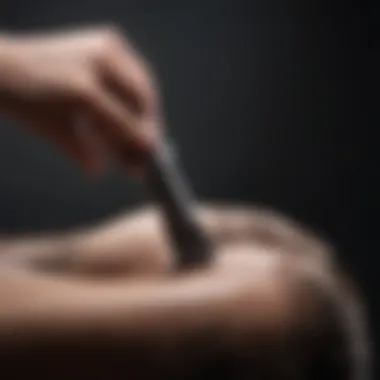How Short Should I Trim My Pubes for Optimal Grooming?


Intro
Grooming practices vary widely across cultures and can greatly influence personal preference. One area that often sparks debate is the grooming of pubic hair. Many wonder about the optimal length for trimming pubic hair and what considerations play into that choice. Factors such as personal comfort, hygiene, aesthetics, and cultural norms each affect these decisions. Understanding how short to trim pubic hair can lead to a more satisfying grooming experience.
In this article, we will explore the various aspects of trimming pubic hair, including methods employed, the health implications tied to grooming habits, and tips for maintaining cleanliness and health. It’s crucial to note that the decision to trim or not trim should be informed by personal preferences and lifestyle choices.
Cultural Considerations
Grooming styles for pubic hair differ significantly among cultures and regions. Some cultures emphasize leaving hair untrimmed to showcase natural beauty, while others advocate for complete removal or specific lengths as a social standard. These differences may stem from varying beauty ideals, historical practices, or even religious beliefs.
- Western Context: In many Western societies, trends lean toward shorter styles or complete hair removal, often linked to perceptions of cleanliness or sexuality.
- Eastern Perspective: Conversely, certain Eastern cultures may favor a more natural appearance, reflecting a broader acceptance of body hair.
Understanding these cultural perspectives can provide a deeper insight into one's own choices about pubic hair grooming.
Personal Preferences and Aesthetics
When it comes to personal grooming, preferences can be subjective. What one individual finds attractive, another may not. Some people prefer a well-groomed appearance, leading them to trim their pubic hair to a specific length. Others may opt for a more natural look, feeling that it suits their body type and lifestyle.
Key factors to consider include:
- Comfort: Shorter hair can sometimes feel less prickly and uncomfortable during intimate moments.
- Hygiene: Proper grooming aids in promoting hygiene, as it can reduce moisture and restrict bacteria growth.
- Aesthetic Appeal: Many individuals feel more confident and attractive when they trim to a desired length.
Health Implications
Trimming pubic hair can have potential health benefits, but it also brings certain considerations. While proper grooming can enhance hygiene and cleanliness, it’s essential to approach this task with care to avoid irritation or cuts.
Health Tips include:
- Trim hair regularly to keep it at a manageable length.
- Use sharp, clean tools to minimize skin irritation.
- Ensure the area is clean before grooming to reduce risks of infection.
Remember to consult with a healthcare professional if you have specific health concerns pertaining to grooming practices.
Practical Tips for Trimming
Achieving the desired length for pubic hair trimming is both an art and a science. Here are practical tips to enhance the process:
- Choose the Right Tools: Invest in quality trimmers or scissors specifically designed for sensitive skin.
- Consider Length: Many prefer trimming to a half-inch, but personal comfort should always be prioritized.
- Create a Routine: Establish a regular grooming schedule to maintain your desired length and condition.
- Moisturize: Post-trim, apply a soothing lotion to nourish the skin and prevent irritation.
By understanding these various aspects, readers can make well-informed decisions regarding their pubic hair grooming practices.
Understanding Pubic Hair
Understanding pubic hair is essential for anyone considering grooming practices. This section delves into the biological purpose of pubic hair and the variations one might experience in growth patterns. Knowing these elements can help in making informed grooming choices.
Biological Purpose of Pubic Hair
Pubic hair serves several biological functions. Firstly, it acts as a protective barrier for sensitive areas of the body. This region is prone to irritation and infections, and pubic hair can help minimize friction from clothing and other physical activities. Additionally, it may play a role in pheromone transmission, contributing to sexual attraction. Hormonal changes influence the growth of pubic hair, linking it to stages of sexual maturity.
Understanding the biological functions provides insights into why some individuals might choose to keep their hair longer or opt for a trim. It's not solely about aesthetics; there are functional elements that might influence preferences.
Variations in Pubic Hair Growth
Variability in pubic hair growth can be attributed to numerous factors. Genetics predominantly dictate hair thickness, curliness, and density. Some people have denser or coarser hair, while others might find theirs to be finer and more sparse.
Hormonal influences also play a major role—conditions like polycystic ovary syndrome (PCOS) can alter hair growth patterns significantly. Beyond biological factors, lifestyle and environmental elements can also impact hair growth and maintenance.
Understanding these variations is critical for developing a personalized grooming strategy. It helps individuals align their grooming techniques with their natural hair characteristics, thus achieving better aesthetic and comfort outcomes.
Reasons for Trimming Pubic Hair
Trimming pubic hair serves various purposes that enhance both individual preferences and practical considerations. Many people choose to trim for reasons such as aesthetics, hygiene, and comfort. Understanding why trimming is important can help individuals make educated decisions about their grooming routines.


Aesthetic Preferences
Aesthetic preferences play a crucial role in pubic hair trimming. Many individuals aim to align their grooming with personal style or societal trends. Some may prefer a polished and tidy look, feeling that shorter pubic hair enhances their overall appearance. Others might find that a well-groomed area boosts self-confidence, especially in intimate situations.
There is no universally accepted standard for what looks best, as it varies significantly among individuals. Factors like body type, skin color, and personal taste will influence what length looks ideal. Ultimately, the decision is personal, influenced by both how someone feels about themselves and how they want to present to others. Many resources suggest styles that fit various body types, enabling people to find what suits them best.
Hygiene Considerations
Hygiene is another important factor to consider when trimming pubic hair. Maintaining a clean area can prevent issues like odor and skin irritation. Shorter hair can improve airflow and reduce moisture accumulation, making it less likely for bacteria to grow. This is especially significant in warmer climates where sweat can lead to discomfort.
Moreover, trimmed pubic hair can simplify personal hygiene routines. It makes cleaning easier and helps in the effective grooming of the area. Familiarity with grooming practices can influence individual experiences and perceptions of cleanliness.
Regular grooming is essential. Keeping the area tidy can be a key component of personal hygiene routines.
Comfort and Sensation
Comfort and sensation are often overlooked aspects of pubic hair trimming. For some, longer hair can lead to irritation or discomfort during activities such as exercising, wearing tight clothing, or engaging in intimate moments. Shortened hair may alleviate those discomforts, making it easier to feel comfortable in one's body.
In addition to physical comfort, some people experience different sensations based on hair length. Though it varies from person to person, shorter lengths can offer a sense of freedom and may enhance tactile experiences. This aspect is highly subjective, and everyone should assess their own comfort levels.
Ultimately, understanding these reasons can lead to more informed choices when it comes to grooming practices. Combining aesthetic desires, hygiene needs, and comfort can provide a holistic approach to trimming pubic hair.
Recommended Length for Trimming
Trimming pubic hair is a personal choice influenced by various factors, including comfort, aesthetic preference, and hygiene. Understanding the recommended length for trimming can help achieve a cleaner appearance while considering safety. The approach to trimming can significantly impact how one feels about their grooming practices. The right length ensures that irritation or potential discomfort are minimized, making it an essential aspect of personal grooming.
General Guidelines
Hair Length versus Skin Exposure
The relationship between hair length and skin exposure is crucial. Longer hair can often trap moisture and heat, leading to discomfort and hygiene issues. Keeping pubic hair at a shorter length reduces this risk. The key characteristic of maintaining a shorter hair length is that it offers both aesthetics and practicality. When pubic hair is trimmed short, the skin underneath remains more exposed, which allows for better air circulation.
This arrangement can also enhance one’s aesthetic by providing a neater appearance. It is a popular choice for those who prefer a clean look without completely shaving. However, achieving a very short length may increase the chance of skin irritation if proper care is not taken during the grooming process. Thus, it is essential to find a balance that works for the individual without risking irritation or discomfort.
Balancing Aesthetics and Practicality
Balancing aesthetics and practicality involves more than just the desired visual outcome. It requires considering how much effort one is willing to invest in grooming. A shorter trim can look neater and more polished, aligning with many individuals' aesthetic standards. However, maintaining this look requires regular upkeep. A frequent trimming schedule may be viewed as burdensome for some.
Thus, the challenge lies in finding a length that looks good but is also sustainable regarding upkeep. One unique feature of striking this balance is that it can cater to both spontaneous grooming and long-term maintenance. For example, a moderate trim may provide a look that is less polished but allows for more time between grooming sessions.
Individual Preferences
Considering Personal Style
Personal style plays an integral role in how individuals choose to trim. Each person’s grooming routine reflects their personality and self-image. Some may prefer a very short trim, while others opt for a fuller look. Understanding one’s style can guide these choices. The importance of this individualized approach is that it can enhance personal satisfaction with one’s grooming practices.
A unique feature of considering personal style is that it adds a personal touch to grooming choices. This can create a unique signature that aligns with other aspects of fashion and style. However, style preference can sometimes conflict with other considerations, such as hygiene or comfort, so it’s essential to be aware of these trade-offs.
Tailoring Trims to Body Types
Tailoring trims to body types is a practical approach to achieving a flattering aesthetic. Different body types may necessitate different trimming styles to complement physical features. For example, individuals with a lean physique may prefer shorter trims, as these can visually elongate the form. Conversely, those with larger body types may find that a moderate trim offers a more balanced appearance.
This adaptability is a key characteristic, as it allows individuals to align their grooming practices with their body type. A unique advantage of this consideration is that it encourages a tailored approach to grooming, which can enhance both comfort and aesthetic appeal. However, it may take some experimentation for individuals to find the length that best suits their body type, making this process an ongoing journey.
It is essential to recognize that trimming is deeply personal. The importance of these choices transcends mere appearance, encompassing comfort, hygiene, and overall wellness.
Different Grooming Methods
The choice of grooming method significantly affects the outcome of pubic hair trimming. Each method comes with its distinct characteristics, benefits, and considerations. Understanding these methods can help individuals make informed decisions about their grooming practices. The importance lies in balancing personal preference with practicality, comfort, and ultimately skin health.
Scissors and Trimmers
Choosing the Right Tools


Selecting the appropriate tools is crucial for effective grooming. Scissors and electric trimmers are common choices. Scissors offer precision and control but require a steady hand and good technique. On the other hand, electric trimmers provide ease of use, especially with adjustable lengths for varying styles. They are a popular choice due to their convenience and speed.
Features such as rounded tips on scissors prevent skin nicks, while trimmers often come with guards for safety. However, with trimmers, the risk of irritation can increase, especially if used improperly. Therefore, choosing the right tool affects not only aesthetics but also comfort during and after trimming.
Technique for Even Trimming
Establishing an even trimming technique contributes significantly to the final look. Using gentle, steady motions ensures that hair is cut uniformly. It is best to trim in a dry environment, as wet hair can slip through scissors or trimmers, leading to uneven results.
A key characteristic of this technique is the importance of patience. Rushing can lead to mistakes or a patchy appearance. Additionally, alternating between scissors and trimmers can create a more layered look and blend different lengths. Both tools provide unique advantages, but mastering technique remains essential for achieving the desired result.
Effects of Shaving
Benefits and Drawbacks of Shaving
Shaving is a popular method for many seeking a clean look. The primary benefit is the smoothness achieved. It can also be a quick option when time is limited. However, there are drawbacks to consider. Shaving may lead to ingrown hairs and skin irritation for some individuals, which necessitates careful maintenance and technique.
A key advantage is the short-term results; shaved areas remain hair-free for a few days. Conversely, for those prone to irritation, the drawbacks can outweigh benefits. Identifying skin sensitivity before choosing this method is essential.
Strategies to Minimize Irritation
Employing effective strategies can reduce irritation from shaving. Using high-quality shaving cream is one of the most beneficial practices. It serves to soften hair and protect the skin. Additionally, utilizing sharp blades ensures a smoother cut, reducing the chance of pulling and irritation.
Another strategy is to shave in the direction of hair growth to minimize tugging. Post-shave care, such as applying soothing lotions, can significantly improve skin comfort. By focusing on these strategies, individuals can enjoy the benefits of shaving with fewer side effects.
Waxing and Other Methods
Comparative Analysis with Trimming
Waxing and other methods offer alternatives to trimming and shaving. Waxing tends to last longer since it removes hair from the root, thus delaying regrowth. However, unlike trimming, which allows for instant adjustment and control, waxing requires additional time and can be painful.
When comparing methods, it is important to consider personal pain tolerance and desired maintenance frequency. This analysis helps in choosing what aligns best with individual grooming goals. Though waxing can offer a clean look, it may not be suitable for everyone.
Long-term Results and Care
Considering long-term results is crucial when selecting a grooming method. Waxing, for example, can lead to softer hair regrowth over time. This aspect may appeal to those seeking a long-lasting solution. However, individuals must commit to aftercare, such as avoiding sun exposure and regularly moisturizing, to maintain skin health.
In contrast, trimming needs frequent touch-ups but is less invasive. It allows for more customizable outcomes. Ultimately, the choice between these methods hinges on personal goals and willingness to engage in necessary ongoing care.
Cultural and Social Considerations
The topic of pubic hair grooming encompasses a broad spectrum of cultural and social considerations. Understanding these elements is crucial for anyone looking to navigate the complexities of personal grooming. Pubic hair trimming does not exist in a vacuum; rather, it reflects deeper social norms, values, and personal choices shaped by cultural contexts. One's approach to grooming can carry implications for personal identity and self-expression, making an awareness of cultural norms not just relevant, but necessary.
Different Cultural Norms
Regional Trends in Grooming Practices
Cultural norms regarding grooming vary significantly across regions. In certain areas of the world, minimal grooming is the standard, while in others, regular trimming or shaving is preferred. For instance, some societies in the Middle East celebrate natural grooming, while Western countries often feature more hair removal as a trend.
This regional variance contributes to a rich tapestry of what is considered acceptable or desirable in grooming practices. The distinct characteristic of regional trends is that they often reflect historical and social factors. For example, in societies where cleanliness is heavily emphasized, frequent grooming may be seen as vital for hygiene rather than a personal aesthetic choice. Conversely, other cultures may embrace a more natural appearance, celebrating body positivity.
The unique feature of these grooming practices lies in their adaptability. A style that’s popular in one region may offer advantages in personal comfort, hygiene, or confidence in another.
Impact of Media on Grooming Preferences
The impact of media on grooming preferences has become increasingly pronounced in modern society. Social media platforms and fashion advertisements heavily shape perceptions of beauty, including preferences around pubic hair grooming. High-profile celebrities often dictate trends, leading many to adopt styles that mirror those they admire.
The key characteristic of this media influence is its rapid dissemination of trends. Grooming practices that gain traction online can change public opinion almost overnight. Such trends may promote certain grooming styles as standard or desirable, effectively pressuring individuals to conform.
While media influences can encourage people to explore diverse grooming styles, there are also potential downsides. Some individuals may feel pressured to maintain unrealistic grooming standards, leading to anxiety or dissatisfaction with their natural appearance.
Peer Influence and Societal Pressure
Understanding Normative Behaviors


Peer influence is a powerful force that shapes grooming behaviors. People often look to their peers to gauge societal norms around grooming, which can create a duality of personal choice and group expectation. Understanding normative behaviors requires acknowledgment of how friends, social circles, and communities impact individual grooming choices.
This characteristic of peer influence is especially visible in places like schools and workplaces, where certain grooming trends may dominate discussions or views about what is considered attractive. Observing these behaviors can be a beneficial tool for individuals seeking to align their grooming with societal expectations while remaining comfortable.
However, aligning one's personal grooming with peer standards can also introduce stress. Not everyone may feel comfortable conforming to what their peers dictate, leading to inner conflict between personal choice and societal pressure.
Personal Choice versus Societal Expectations
Navigating personal choice and societal expectations is a nuanced undertaking. While some individuals feel empowered to embrace unique grooming styles that reflect their identity, others may wrestle with the weight of external opinions. The balancing act between maintaining individuality and fitting into societal standards is complex, often leading to various grooming choices.
The key feature of this dynamic is the degree to which individual grooming practices reflect personal values. Choosing to groom for one’s self versus grooming to gain approval from others can shift the narrative in significant ways.
Though embracing personal choice around grooming often fosters self-confidence, challenging societal expectations can also introduce a sense of isolation or judgment. Striking a balance between these elements is crucial for achieving both personal satisfaction and social harmony.
The way societies perceive pubic hair grooming reflects a combination of cultural heritage, individual belief, and social conditioning.
Understanding these cultural and social considerations allows for a more informed approach to grooming practices. It emphasizes the importance of self-awareness and respect for diverse perspectives on grooming.
Health Implications of Grooming
Grooming practices, especially in sensitive areas such as pubic hair, carry important health implications. Understanding these aspects goes beyond aesthetics. It involves knowing how grooming methods can affect skin health, prevent infections, and when to seek professional advice if issues arise. This knowledge not only guides personal grooming choices but also enhances overall well-being.
Maintaining Skin Health
Irritation from Grooming
Irritation resulting from grooming can be a common issue. It typically occurs due to methods that are too aggressive or not suitable for sensitive skin. Key characteristics of this irritation include redness, itching, and, in some cases, small bumps. Recognizing these symptoms is crucial, as persistent irritation can lead to further complications, like ingrown hairs or infections.
Keeping the pubic area well-groomed is beneficial for various reasons. However, opting for gentler methods can help reduce the risk of irritation. Tools like specialized trimmers or scissors can minimize unnecessary friction. Moreover, using moisturizing creams post-grooming aids skin recovery. In this article, we emphasize the significance of choosing appropriate grooming tools and techniques. Understanding this aspect helps in maintaining healthy skin and preventing discomfort.
Preventing Infections
Preventing infections is another critical consideration. Different grooming methods, especially those that involve cutting or shaving, can create small nicks or micro-abrasions in the skin. These openings can become entry points for bacteria. Key characteristics of infection prevention include using clean tools and applying antiseptic treatments post-grooming.
It is beneficial to maintain cleanliness and proper hygiene practices. This includes regularly disinfecting grooming tools and using specific products designed for intimate areas. These practices lower the chance of developing infections, making grooming safer. Knowing how to properly care for the skin before and after grooming directly impacts health.
When to Seek Professional Help
Identifying Potential Issues
Being aware of potential issues is vital. If irritation or any other symptoms persist, seeking professional help is a wise choice. Key characteristics include redness, abnormal growths, or unexplained pain. Noticing such signs can be crucial. Identifying these issues early can prevent more severe problems, which is beneficial to your overall health.
Recognizing the signs that warrant professional assistance ensures timely intervention. This article emphasizes the importance of being alert to changes in the skin's condition.
Understanding Treatments and Solutions
Understanding available treatments is essential for anyone facing skin issues post-grooming. Options range from topical treatments to professional dermatological care. Key characteristics of effective treatments often involve addressing the root cause of irritation or infection.
It is beneficial to explore a variety of solutions tailored to specific problems, such as creams for irritation or prescription medications for infections. Knowing about these options gives readers the tools to tackle issues effectively. This article highlights the importance of understanding both the issues and the treatments available, helping readers make informed decisions for their health.
Finale: Informed Grooming Practices
In the landscape of personal grooming, understanding how to trim pubic hair is not simply about aesthetics; it encompasses health, comfort, and individual choice. The decisions made in this realm are often influenced by cultural standards, societal expectations, and personal preferences. In this article, we have delved into various factors influencing grooming practices, ensuring readers are equipped with essential knowledge to make informed choices.
Summary of Key Points
To encapsulate the main insights presented:
- Biological Role: Pubic hair serves protective functions, and trimming should not overlook this aspect.
- Cultural Perspectives: Different cultures have varied grooming norms. Awareness of these norms can inform personal decisions.
- Health and Hygiene: Proper grooming can lead to better hygiene; however, it comes with risks such as irritation and infection.
- Preferred Lengths: Each individual's ideal trim can vary significantly based on personal taste and lifestyle.
- Grooming Methods: From scissors to waxing, there are diverse methods with distinct benefits and drawbacks, each affecting results and comfort.
This summary serves only as a reminder of the intricacies involved in the simplest of decisions surrounding personal grooming.
Encouraging Individual Choice
Choice is central to the experience of grooming. While societal pressures often whisper what is considered attractive or acceptable, it is vital to prioritize personal preferences. Everyone has different comfort levels and stylistic desires, which should guide their grooming practices. Experimentation may lead to discovering a personal style that resonates with one’s identity.
Furthermore, embracing one’s unique grooming habits encourages a broader acceptance of diversity. When individuals tailor their approach to suit their lifestyle, it can foster a sense of empowerment and body positivity.
Ultimately, informed grooming practices should not just reflect what others deem necessary but should stem from an understanding of personal needs and aesthetic desires. This empowers readers to control their grooming practices while maintaining a mindful attitude towards health and hygiene.















